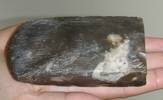The palisade south of Gormsgade
By Anne Pedersen
The Jelling Project began its archaeological digging season for 2010 on the 10th of May with an excavation at Gormsgade 7-9 in Jelling. Vejle Museum is in charge of the excavation. The museum has excavated within the two plots before, but with the results produced by the 2006-2007 excavations north and north-east of the Jelling monuments, it was clear that the area should be looked at again. It was assumed that the tip of the enormous ship-setting would be found here, as well as the southern line of the large palisade fence.
Two areas were opened up. One was immediately south of Gormsgade, near the South Mound, and the other to the south of this, where the fence line was thought to be located. Unfortunately the area near the South Mound did not produce any significant results, and no post hole comparable to the one of 1.7 m depth found with the group of large stones north of the North Mound in 2007. These stones have been interpreted as the tip of a huge ship-setting of around 350 m in length. Neither were there traces of large standing stones similar to those found under the South Mound. However, it should be noted that there was disturbance down to a significant depth due to house cellars. A sample was taken for TL (thermoluminescence) dating and the square excavation area was then filled back in again.
On the other hand the excavated area across the two plots produced an important result. During the first week the line of the palisade was revealed in the eastern half of the area, exactly where it was supposed to be. The foundation trench was around 17 m long and completely in line with the sections we have seen from the excavation of the palisade north-west of the monuments and its western course in Vestergade. There is significant variation in the colour of the fill and furthest to the east up to 60-65 cm is preserved under the cleaned-up surface, which is promising for providing information about the palisade’s construction.
The find of a flint axe
The following week the western part of the area was excavated with a machine and the palisade was revealed along all of the more than 30 m long trench. In the west a small depression was visible, which was once waterlogged like the other hollows found in trial trenches north and north-east of the monuments in 2009. The palisade’s ditch cuts this deposit and is therefore of a later date. A possible date for the hollow is suggested by a surprising find, a fragment of a very fine thin-butted flint axe from the early Neolithic period. The axe dates to around 3500 BC and has nothing to do with Harald Bluetooth and the Jelling monuments, but shows that the Jelling area was inhabited at the time of the earliest farmers.
The Jelling Project continues here
After the excavation in Gormsgade we continue from mid-June in ‘the Market Place’ behind Jelling Kro. Here we hope to find the large palisade structure’s north-west corner. This will be followed after the summer with an investigation of the gravel area east of Smededammen, with the objective of finding the structure’s south-east corner. Vejle Museum is in charge of both excavations. In June the Jelling Project, together with Aarhus University and Vejle Museum, also begins the excavation of the palisade structure’s north-eastern quadrant, north and north-east of the North Mound. In this area we expect to learn more about activities that occurred within the impressive structure. Site tours of the excavations are arranged for June and July. Information about these can be obtained from Vejle Museum or Royal Jelling.
In 2009 boreholes were made into the North and South Mounds. This project continues in 2010 and in August-September boreholes will be drilled into the Many Mounds. The aim is to increase our knowledge of the prehistoric landscape around the monuments and provide a basis to compare the two huge mounds with. Are they like or unlike the other prehistoric mounds in Jelling?





